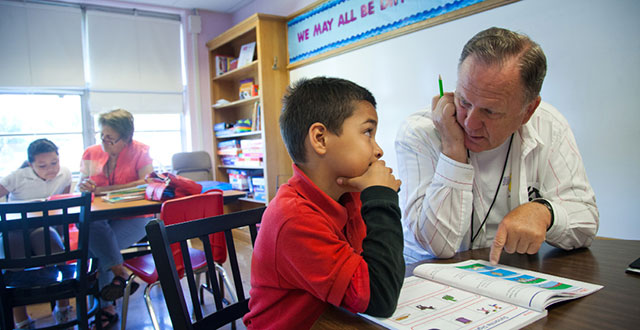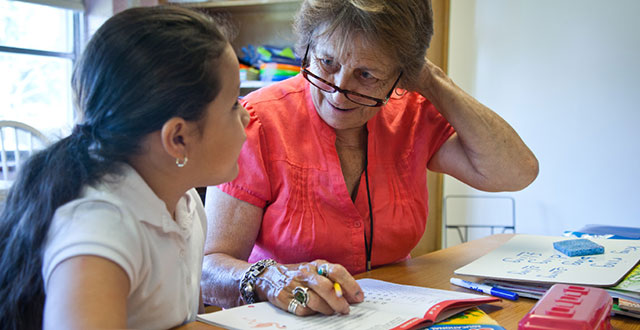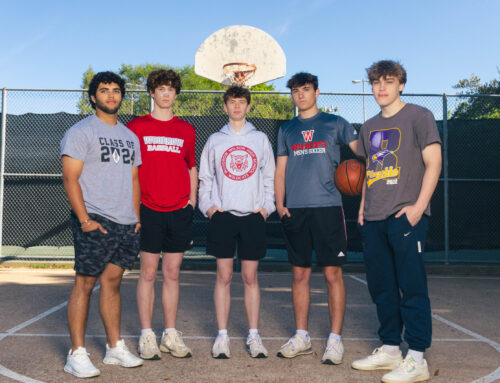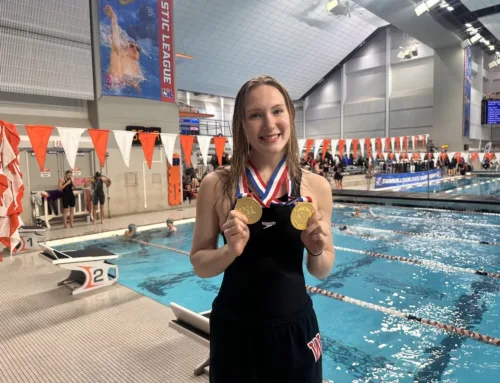Dan Micciche walked into Fannin Elementary on a mission from his law firm, Akin Gump. Micciche had glimpsed the elementary on Ross Avenue through the skyscraper windows of his firm’s office Downtown, and he knew its students came from impoverished households. That was about all he knew of Fannin.
With no children of his own, Micciche’s only prior interactions with Dallas ISD had been one-off volunteer events. But the Akin Gump higher-ups wanted to see a partnership develop between its attorneys and a Dallas school, so in 2005, he and his colleagues set out to make it happen.
They had great intentions of helping the students but stumbled in their initial attempts. Some of their first projects involved painting the cafeteria — “twice,” he says — and organizing a Christmas gift drive. This was all well and good, Micciche says, but their efforts were misplaced.
“Just getting them toys wasn’t really going to aid in the mission we had, which was to raise student achievement,” Micciche says. “We kind of learned the hard way.”
They began purchasing educational resources instead — books for the library and jump ropes for physical fitness — and ultimately worked with Fannin’s staff to develop a tutoring and mentoring program in which the Akin Gump attorneys spent regular, one-on-one time with the students.
That’s when Micciche really began to see results. Fannin already had a solid staff that worked hard and, despite the students’ challenging socioeconomic backgrounds, earned state ratings of “acceptable” and “recognized,” he says. When volunteers began working in tandem with the staff, the school soon earned an “exemplary” rating.
“They were extremely poor kids, and parents of kids who live in poverty generally are not educating their kids the same way that middle-class parents are — teaching ABCs, how to count, how to write their names,” Micciche says. “You’re trying to fill that gap that was created by parents in poverty not knowing what to do.”
Fannin closed in 2012 when DISD shut down 11 underutilized campuses in an effort to save money, but the experience was life-changing for Micciche — so much so that the White Rock area resident ran for the DISD board of trustees and was elected in May 2012. One of his first major pushes was a tutoring program that could be implemented at elementary schools district-wide, partnering willing and able volunteers with campuses that know how to maximize their time and skills.
“A good percentage of kids coming to school on the first day don’t know how to write their name,” Micciche says. “They’re years behind. We’ve got to catch them up.”
The little school that could — and did
Candice Ruiz became principal of Kiest Elementary in the Casa View Oaks neighborhood right around the time Micciche was elected. The school’s performance the year before Ruiz’s arrival had been declared “academically unacceptable,” and she readied herself for the challenge ahead.
Kiest is in Micciche’s District 3, and when he met Ruiz, he believed her gumption combined with a volunteer program similar to Fannin’s might be just the thing to turn Kiest around. Micciche suggested the idea to her, promising to recruit volunteers and enlist support from DISD administrators who coordinate the district’s volunteer partnerships.
“I’m looking at him, I’m a rookie principal, and I have ‘academically unacceptable’ status on my head,” Ruiz recalls. But she didn’t play it safe. “I put my heart into something, got buy-in from my staff, and we did it.”
Micciche and Ruiz reached out to neighborhood churches, the Casa View Oaks Neighborhood Watch, parents and anyone else who gave them an audience. They asked people to commit an hour or two each week to spend time reading with children who were lagging behind. The program launched in the middle of the school year, and by fall 2013 had grown to 35 volunteers.
The task wasn’t easy. In the beginning, some of Kiest’s fifth-graders were reading at a second-grade level, Ruiz says, and volunteers would express doubts about making any progress. Ruiz simultaneously made changes in the classrooms, where both teachers and teachers’ assistants spent more dedicated time on reading.
“Reading is the gateway to all other content areas,” says Jolee Healey, executive director of the Bryan Adams High School feeder pattern, to which Kiest feeds. “In upper grades, they are reading to learn.”
Healey also is the decorated former principal of Hexter Elementary and took that school from a place of academic instability to its coveted Blue Ribbon status by the end of her tenure. So she knows a thing or two about how to turn a school around.
If students are not reading at grade level by first grade, they are 80 percent less likely to do so by fourth grade; if they are behind in third grade, they may struggle to graduate, Healey says. College readiness “doesn’t start in high school,” she says.
The students at Kiest were in danger of succumbing to these statistics. At the beginning of the year, less than half of its first-graders were reading at grade level, and a third of them were really struggling behind, Ruiz says. By May, however, the bar graph showed a remarkable shift. When Micciche looked at the numbers, even he was floored: Three-fourths of first-graders were reading at grade level, and almost all of the rest were well on their way.
“I knew they would be helping a lot of kids,” he says of Kiest. “I didn’t know they would blow the doors out.”
‘Any child can blossom’
At their last tutoring session before the end of school, Jerri Shevlin handed a first-grade girl a few small books to take home with her.
“You might need to get your dad to help you with these, but you need to read this summer,” Shevlin implored her.
Shevlin had spent 30 minutes, twice a week, almost every week of this past school year reading with the girl. At the beginning of the year, she wasn’t testing well, but as the tutoring sessions continued, “she just blossomed as a reader,” Shevlin says.
“We’re not any kind of miracle workers. If we have them all year and you can consistently reinforce and give them that attention, any child can blossom,” Shevlin says.
Shevlin, a member of the Casa View Oaks Neighborhood Watch, says she and other watch members enlisted as tutoring volunteers because they had heard the school was struggling and wondered if they could help. Betty Rice-Nure, Shevlin’s morning walking buddy, also signed up, but she was hesitant.
“Every morning as it got closer, I would tell Jerri, ‘I just don’t know if I can do this. I never wanted to be a schoolteacher,’ ” Rice-Nure says. “The day arrived, and Jerri told me, ‘Just come and try it one day. If you don’t like it, don’t do it.’ ”
But “it was wonderful,” she says. “I fell in love with it.”
The consistency is what makes the difference, the tutors say. The first year, Rice-Nure worked with the same two students from start to finish and saw amazing progress. This past year, just as she felt she had “made a breakthrough” with her two boys, they moved away over the holidays. It was disappointing to Rice-Nure, but she believes her time with them mattered.
“Knowing that you have reached those children on a personal level — you relate to them, they relate to you — you build on that,” she says.
Roughly 94 percent of Kiest’s students come from impoverished families. “I don’t think these children have a lot of books in their homes,” Rice-Nure says. She, Shevlin and others shop at dollar stores and thrift stores to find easy readers for them. The tutors also exchange tips and suggest books to each other, says Julissa Marquez, a Kiest parent and one of the school’s two bilingual tutors. Marquez thought she was signing up to read in the classroom once in a while, as she had done in the past. Tutoring required more of her, but even though she says it was hard at times, she stuck with it.
“One of my students went in there having such a hard time reading, and it was a huge payoff,” Marquez says. By the year’s end, “his teacher told me he was one of the top readers in the class. He just was kind of shy and lacked that confidence. It made me feel really good.”
Success is the fuel that drives these tutors. They love to see “that little light go on,” as Shevlin puts it.
“They’re really connected,” Kiest counselor Keich Willis says of the tutors and students. “The volunteers are kind of like teachers — they can see the growth themselves.”
And the numbers don’t lie. The number of first-graders reading at grade level grew from 44 percent at the beginning of the 2013-14 school year to 74 percent by the end, with only 3 percent still in the “really struggling” territory, Ruiz says.
“Kiest went from a failing school to passing everything with flying colors,” Rice-Nure says. She gives the credit to Ruiz, whose enthusiasm was “contagious. She made you want to help that school.”
Ruiz’s success was rewarded with a promotion at the end of the 2013-14 school year; this year, she is the principal at Hill Middle School, also in the Bryan Adams feeder pattern. The volunteers are hopeful about her successor and plan to keep tutoring.
“We don’t know that our tutoring had a lot to do with [Kiest’s success], but who knows?” Rice-Nure says. “I’m sure it helps a little.”
No more ‘busy work’ for volunteers
When huge academic gains are made at DISD schools, there is a hardworking staff behind it, Micciche says. He learned that at Fannin.
“You could see how dedicated they were and immediately got out of your mind that the reason some DISD school is not performing well versus Highland Park was a lack of commitment on the part of teachers,” Micciche says. “These teachers are doing a lot more to improve a child’s education and well-being and life than someone teaching in a suburb.”
At the same time, he believes strongly in the impact community volunteers can make, especially at the elementary level. Micciche recently drove past Kiest and saw these words on its marquis: “Change a life. Be a tutor.”
“You don’t get that from the yardwork,” he says. Landscaping projects and cafeteria murals along the lines of Akin Gump’s early Fannin efforts are appreciated, no doubt, Micciche says, “but where we need the most help — and where you can have the greatest impact — is helping a child to read at grade level.”
By the time students reach third grade, Ruiz says, “they learn so much of the content by reading that if they’re not reading, they’re missing out.” Micciche says the district is not giving up on kids in upper grades, but “intervention at the earliest possible age is the most effective.”
This is why Micciche championed a policy that formalizes instructional tutoring programs at elementary schools across the district, which DISD trustees passed last November. A few such programs existed here and there, some piloted by the district and some built from scratch, but Micciche wanted to see programs across the board that would be based on research, proven to work and easy for schools to implement.
“If a qualified person comes to a school to volunteer, we don’t want her being turned away, or asked to do busy work, make copies or work in the cafeteria if she can instead participate in an effective tutoring program,” Micciche said in a February 2013 memo to fellow trustees.
“Obviously, the worst thing we can do is to have a volunteer program where the volunteers don’t really help but simply get in the way of our teachers and principals while they are trying to do their jobs.”
He was speaking from his own experience at Fannin. That experience led him to believe that community members truly do want to help Dallas schools and, conversely, schools truly do want help. But the district lacked a method to match the two in a way that effectively impacts student achievement — until now.
This fall, every elementary school in DISD is seeking volunteers to be reading tutors for children. For too long, the community has been an “untapped resource,” Micciche says, but now he hopes it will be “a lever we can use to help raise student achievement.”
And anyone who can read can “change the world for a child,” he says.
“I think people are hesitant if they don’t have experience, but most of us, if we care, we can stay ahead of a first-grader,” Shevlin says. “Everyone tutoring has had questions — am I doing any good? Am I making a difference? I personally don’t think we can do any harm. If they can’t read, they’re not going to do well very long, and eventually they’re not going to make it.”
But if you have an hour or two to give each week, she says, “the benefit to the children is immeasurable.”
Additional reporting by Kim Leeson
Whatever time you have to offer, a first-grader can use it
Now that the school year has begun, all 151 elementary schools in DISD need volunteers, and the good news, says Janie Peña, executive director of Volunteer and Partnership Services, is “we have something for everybody.”
“What we want to do is have options for people to come in and use their talents, and it still meets the needs of the child,” Peña says. “We recognize that we need help, we recognize that people are wanting to help, and we are appreciative of that.”
Whether volunteers have an hour a week, three hours a day or a couple hours on occasion, that time can be used in a valuable way at a DISD school, Peña says.
“We want purposeful instruction for the children from our volunteers, and we want our volunteers to feel that they have really touched a life,” she says.
Every volunteer has to go through a clearance process for safety and security reasons, she says, and will receive a brief overview of DISD along with some basic training. Tutoring volunteers, such as the ones at Kiest Elementary, undergo additional training.
To sign up, call the district’s Volunteers and Partnership Services office at 972.925.3920 or visit dallasisd.org/partners.







